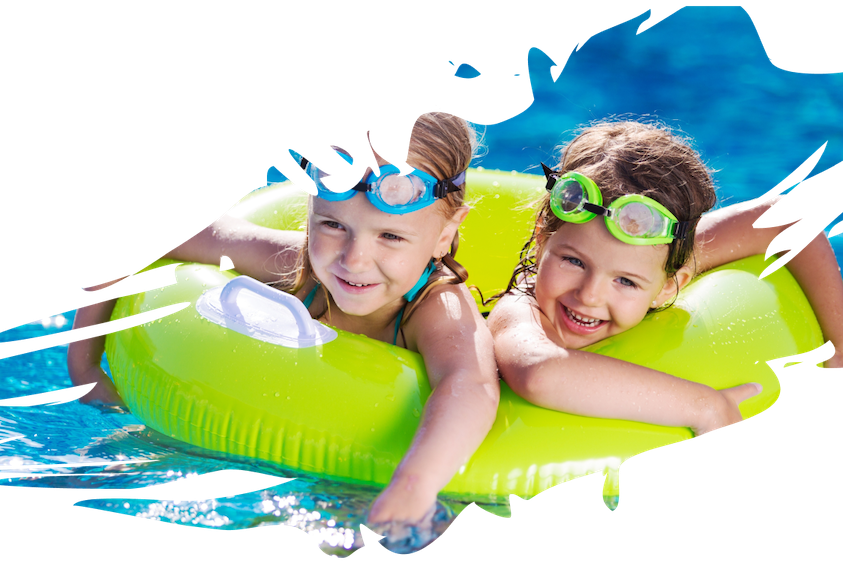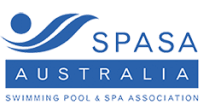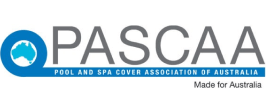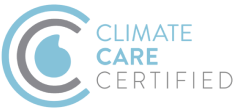Product Guides & Information
Breathable Pool Covers?
Breathable Pool Covers?
Recently, the industry has seen the introduction of a so-called “breathable pool cover”. At Daisy Pool Covers, we were intrigued by this new pool cover with holes punched in it and thought we would explain what they do and how they work. While many may think that “the latest product is usually the greatest”, we did our homework to discover what makes them different, or not so different to the market leading solar pool covers that Daisy have been producing since 1983.
Taking a close look at this new breed of pool cover, they are designed with holes punched though the cover. The covers benefits claim that when you allow your pool to breath, it results in a cleaner, longer lasting pool and a healthier swimming environment. What the team at Daisy Pool Covers discovered was no matter what type of pool cover you purchase, there is absolutely no alternative to looking after your pool’s chemical balance and uncovering your pool water once in a while.
The key to longevity in your pool cover, surface and equipment is keeping your chemical balance consistent. If you keep your pool water balanced, as recommended by SPASA Australia, you will not reduce the lifespan of your equipment, pool surface or pool cover. Not only will it save you money in the long run (out of balance water can cause expensive damage to your pool), but your swimming experience will be so much better without your pool being unbalanced or dangerous to swim in.
The Daisy Day was designed to educate pool owners to remove their pool cover to let the pool breathe and test the pool water. This is to ensure pool owners are keeping an eye on their water balance, to make sure there isn’t an imbalance, causing damage to their cover or equipment down the track. The Daisy team works hard to actively promote best practice pool and pool cover usage to prolong the life of all pool surfaces, pool covers, equipment; giving customers the best swimming experience possible.
What does a breathable pool cover do?
A breathable pool cover is meant to release gases from the pool water into the air through tiny holes punched into the pool cover, whilst stopping evaporation of pool water. We’ve taken a look at the claims made by breathable pool covers and given our own opinion based on industry knowledge, research and testing out in the field.
A “breathing” pool cover won’t be able to correct an out of balance pool. Fibreglass resin suppliers, along with the swimming pool industry, know that without correct water balance you will get a myriad of problems from damaging the pool’s surface to shortening the life of pool equipment (covers, pool cleaners, pool toys – anything the water comes into contact with) as well as a potentially dangerous swimming environment.
Pool covers don’t cause incorrect water balance, and they cannot fix it either. Best practice is to use a pool shop that you trust to regularly check and maintain the water chemistry.
A misconception not widely known, is all pool covers are technically breathable. They are made of Polyethylene (PE) a material that by its chemical nature naturally allows a gas transmission rate for oxygen, carbon dioxide and other gasses including chlorinated gases. There been a huge amount of research completed by Sealed Air (the inventor of original bubble wrap and solar pool covers) that shows that PE pool covers do actually breathe. For a 500 micron pool cover, the oxygen transmission rate would be approximately 500cc/m2 per 24 hours at 23°C, meaning PE pool covers do naturally ‘breathe’.
Sealed Air (the Australian company that make Daisy Pool Covers raw materials on Daisy’s dies) invented the Bubble Wrap technology, and believe me, they know their stuff, especially when it comes to the ins and outs of “Moisture Vapour Transition Rate” (MVTR) and the “Oxygen Vapour Transition Rate” (OVTR). The original bubble wrap was designed with a Nylon barrier layer to stop the air and other gasses moving through the material to avoid the packaging bubbles deflating during use. The pool cover formulation was redesigned to allow the pool cover material to naturally breath, without requiring additional holes.
Breathable pool covers still need to be removed regularly, like all other pool covers; they aren’t a set and forget option like they might appear. Pool owners will still need to remove their pool covers, no matter which one they buy, to ensure they are regularly testing their pool water and retain chemical balance in the pool.
The FAQ section from the breathable pool cover website states:
Can we leave our breathable pool cover on permanently or for long periods of time?
It is not recommended that any solar blanket be left on a pool permanently. Aquavent is no different in this respect and should be removed for maintenance as per the Maintenance Guide.
Pool owners should be checking the following regularly:
Chlorine level
pH
Total Alkalinity
Calcium Hardness
Please click here for more information on swimming pool water balance.
Breathable Pool Cover Testing
Let’s look at the testing methods and results that have been conducted by Aquavent.
First Test
The testing done on the “breathable pool covers” included the following:
3 small tubs with no specified volume
Added approximately 2.5mg/L of granular pool chlorine
Measured chlorine levels over 7 days
 Results
Results
97% chlorine loss over 7 days with Aquavent pool cover
96% chlorine loss in an open tub (no cover)
62% chlorine loss with a Daisy cover
pH levels roughly the same
Water temperature is warmer with a Daisy pool cover (20.1 degrees) than with Aquavent (18.3 degrees) and no cover (17.8 degrees)
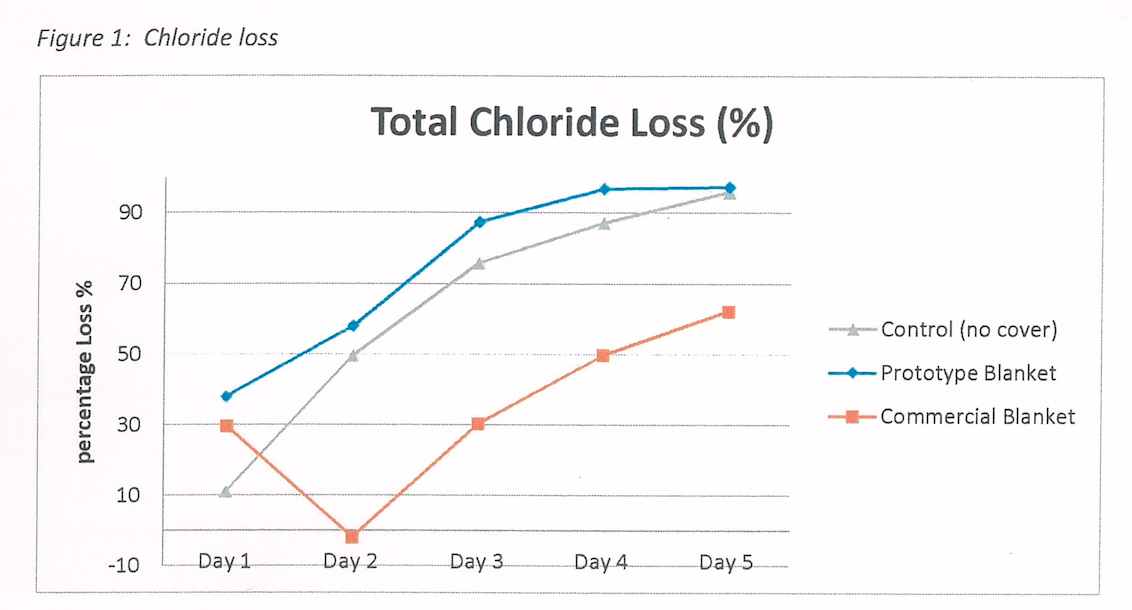 Finding
Finding
Using an Aquavent “breathable pool cover” does not keep chemicals in the pool nor does it keep the water warm. They claim that a Daisy Pool Cover has a higher pool chlorine level, that adding a normal dose of chlorine each week will result in over-chlorination of the pool. This finding doesn’t take into account the fact the pool owner would be dosing their pool based on pool water testing. If the chlorine levels were adequate, no chlorine should be added. In fact, the testing indicates to the contrary. You will need to use more chemicals with an Aquavent cover than you do with a Daisy pool cover to properly maintain the pool water. AND, you will need to consume more power to maintain the water temperature
Second Test
The test was conducted similar to the first test, but the initial water chlorine level was 5mg/L.
Then each day, an additional 2.5mg/L was added. Because chlorine doesn’t escape as much with a Daisy cover, after 7 days the Daisy sample had 8.7mg/L of chlorine prior to the final dose, versus the Aquavent cover which had 3.1mg/L.
The average chlorine loss per day for Aquavent was 39% versus Daisy at 15% and no cover had 21% loss.
The odd result from this test is that Aquavent covers had a HIGHER loss of chlorine than if you had no pool cover at all!
The final test was water transmission for evaporation:
Daisy was 0.03g/h.m2 (grams per hour per square metre).
Aquavent was 0.26g/h.m2
No cover/open tub was 67g/h.m2
In essence, Aquavent has a water transmission rate (evaporation) is 8.66 times greater than Daisy.
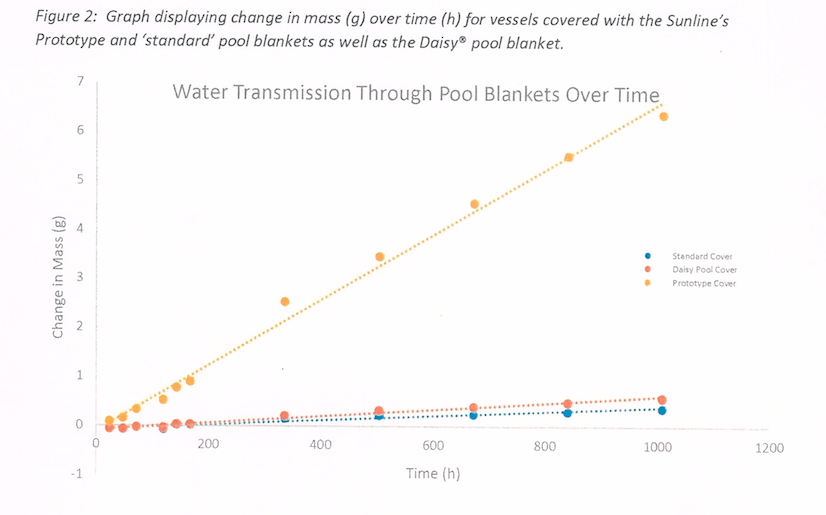 Overall findings from testing
Overall findings from testing
The so-called “breathable” pool cover testing indicates the Aquavent cover will maintain chemical levels lower than an uncovered pool. This just isn’t possible as it would mean you would go through MORE chlorine than with a completely uncovered pool.
In the Aquavent testing, there is no allowance for testing water or adjusting the water balance. Some level of dosing will always be required in a well-managed pool. The testing regime undertaken is continually adding chemicals to the water without any rationale to test the water to see what dosing is required.
The Aquavent FAQs state that they are no different to other solar pool covers and no pool cover should be left on permanently. They state that pool covers should be removed for pool maintenance for as per their Maintenance Guide.
The FAQs also warn, pool damage can still occur through poor pool maintenance.
Additional Testing

July 17th – Installation Day
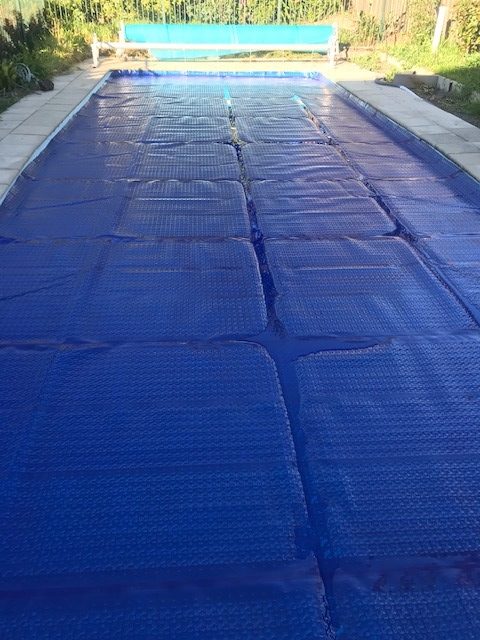
July 18th

August 7th, no rain.
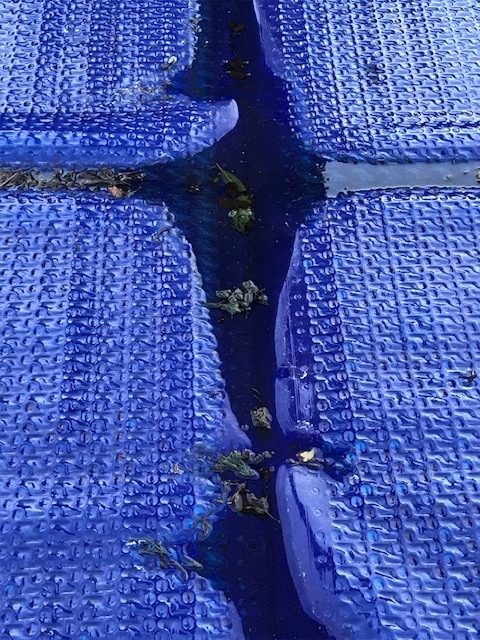
August 15th, no rain.
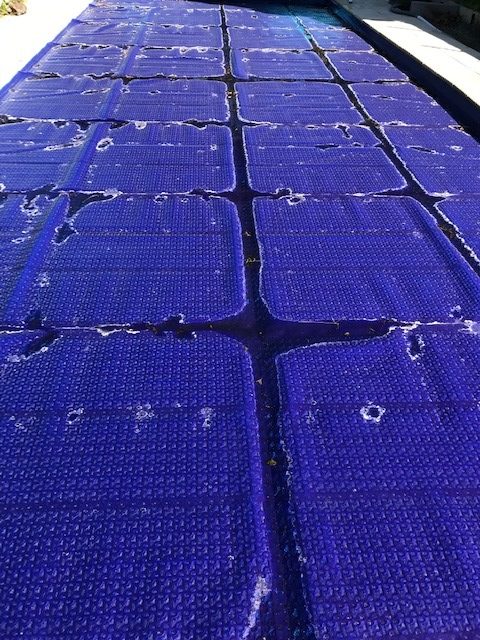
August 18th, no rain.
As you can see from the photos of the Aquavent pool cover, there is water sitting on top of the pool cover (over one month without rain, you can see from the day the cover was installed there is no water on top). The day after installation, water was pooling on top of the cover and then showing the same amount of water on top after 3 weeks and then 4 weeks.
This means:
Evaporation rate for 100% where water sits on top of the cover as water is evaporating, then re-filling (supposedly seeping through the “breathing holes”).
Insulation and heat saving are zero where the water is sitting on top of the cover. Heat transference is dissipated through the water surface. If there is a cover or membrane that has water on both sides, there is zero insulation. Traditional solar covers get some water on top of the cover during operation or rain but that either drains into the pool or evaporates quickly which will leave no water on top of the cover.
Water Ingress into the Bubble Hole
Simple testing of the Aquavent shows the vent hole sits in the water. When we put a sample piece of the cover material on the water the ‘vent and drain’ bubble was touching the water. This means (according to Aquavent themselves) that the vent hole touching the water would make the ‘venting’ of chlorine or any gas trapped in the pocked under the cover redundant.

Holes sitting on the water
Water seeps through the cover and sits on top (see photo below). Water also can’t drain out of the bubble if the hole at the bottom is touching the water. You can see by the image below that the water can’t drain from the ‘vent and drain’ bubble as it is in the water. If the chlorine dissipates through the holes but water remains in the bubble, it’ll be untreated and may well turn green.
This simple test showed that after a relatively short period of time without being in the swimming pool environment water did enter the bubbles through the vent holes that they were supposed to drain out from
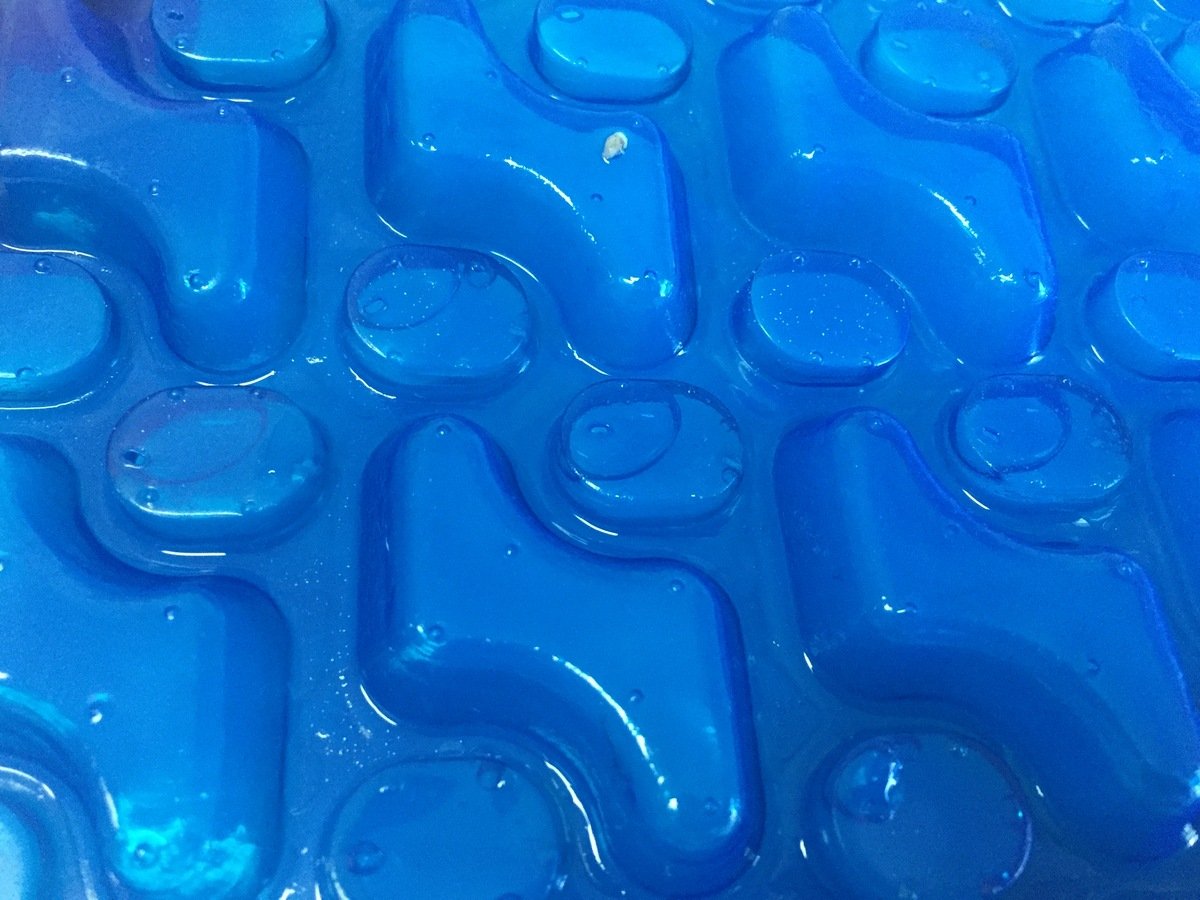
This would also bring into question how heavy the cover will become with all the water that cannot drain out. The small sample was significantly heavier with the retained water. A traditional cover (without holes) will increase in weight by approximately 50% with water hanging on the outside of the bubbles as they are removed off the swimming pool. Pool covers with holes that retain water in the bubbles will dramatically increase the weight of the pool cover.
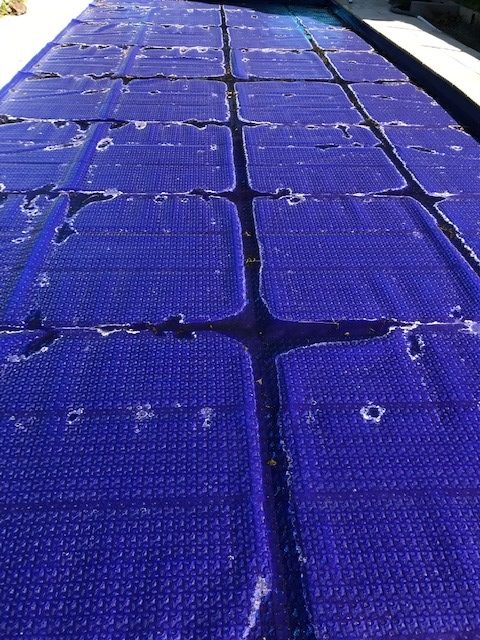
Water on top of Aquavent cover exactly 4 weeks after installation with no rain.
With water being retained in these holes, a build-up of debris, dust and salts will occur over time, stopping any perceived benefit that these holes may have.

Water in the pool cover bubbles
In conclusion, Daisy does not believe there is any net gain from having a pool cover with holes punched into it. Daisy, along with industry leaders, believe the breathable pool cover is like a square wheel, great to be new in the industry, but it just does not perform to the standard that Daisy Pool Covers sets for itself.




